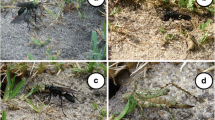Abstract
Diplonychus indicus is a highly versatile predator that forages both actively and from ambush. However, no correlations between predatory mode changes and predatory performance have yet been evidenced. The hypotheses that time spent foraging actively was proportional to time spent locomotory active and that time spent ambushing was proportional to time spent quiescent were tested during animal development. Locomotory activity increases during development due to increases in both frequency and duration of swimming bouts. The frequency of position changes increases as well. Eggbearing males were less active than other adults. However, the proportion of active foraging did not vary significantly with developmental stage and no correlations between activity level and predatory mode were found. Changes in predatory tactics inDiplonychus indicus differ from those reported in other predators as they are not related to any of the usual biotic or abiotic factors.
Similar content being viewed by others
References
Akre, B.G. & D.M. Johnson 1979 Switching and sigmoid functional response curves by damselfly naiads with alternative prey available.J. Anim. Ecol. 48: 703–720.
Blois, C. 1985 Variations of predatory behaviour inAnax imperator larvae in relation to different prey types.Biol. Behav. 10: 183–214.
Charnov, E.L. 1976 Optimal foraging, the marginal value theorem.Theor. Popul. Biol. 9: 129–136.
Cloarec, A. 1969 Etude descriptive et expérimentale du comportement de capture deRanatra linearis au cours de son ontogenèse.Behaviour 35: 84–113.
Cloarec, A. 1989 Variations of foraging tactics in a water bugDiplonychus indicus.J. Ethol. 7: 27–34.
Cloarec, A. 1990a Variations of predatory tactics of a water bug during development.Ethology 86: 33–46.
Cloarec, A. 1990b Factors influencing the choice of predatory tactics in a water bug,Diplonychus indicus Venk. & Rao (Heteroptera: Belostomatidae).Anim. Behav. 40: 262–271.
Cloarec, A. 1991 Predatory versatility in the water bugDiplonychus indicus.Behav. Proc. 23: 231–242.
Cloarec, A. 1992 The influence of feeding on predatory tactics in a water bug.Physiol. Entomol. 17: 25–32.
Cook, W.L. & F.A. Streams 1984 Fish predation onNotonecta (Hemiptera): relationship between prey risk and habitat utilization.Oecologia 64: 177–183.
Crowley, P.H. 1979 Behavior of zygopteran nymphs in a simulated weed bed.Odonatologica 8: 91–101.
Formanowicz, D.R. Jr. 1982 Foraging tactics of larvae ofDytiscus verticalis (Coleoptera: Dytiscidae). The assessment of prey density.J. Anim. Ecol. 51: 757–767.
Giller, P.S. & S. McNeill 1981 Predation strategies, resource partitioning and habitat selection inNotonecta (Hemiptera: Heteroptera).J. Anim. Ecol. 50: 789–808.
Gillespie, R.G. & T. Caraco 1987 Risk-sensitive foraging strategies of two spider populations.Ecology 68: 887–899.
Heads, P.A. 1985 The effect of invertebrate and vertebrate predators on the foraging movements ofIschnura elegans larvae (Odonata: Zygoptera).Freshw. Biol. 15: 559–571.
Johansson, A. 1991 Caddis larva cases (Trichoptera, Limnephilidae) as anti-predator devices against brown trout and sculpin.Hydrobiol.211: 185–194.
Johansson, A. & F. Johansson 1992 Effects of two different caddisfly case structures on predation by a dragonfly larva.Aquatic Insects 14: 73–84.
Kamil, A.C. & H.L. Roitblat 1985 The ecology of foraging behavior: implications for animal learning and memory.Annu. Rev. Psychol. 36: 141–169.
MacArthur, R.H. & E.R. Pianka 1966 On optimal use of a patchy environment.Amer. Nat. 100: 603–609.
Murdoch, W.W. & A. Oaten 1975 Predation and population stability.Adv. Ecol. Res. 9: 1–131.
Okada, H. F. Nakasuji 1993 Comparative studies on the seasonal occurrence, nymphal development and food menu in two giant water bugs,Diplonychus japonicus Vuillefroy andDiplonychus major Esaki (Hemiptera: Belostomatidae).Res. Popul. Ecol. 35: 15–22.
Pulliam, H.R. 1974 On the theory of optimal diets.Amer. Nat. 108: 59–74.
Sih, A. 1981 Stability, prey density and age-dependent interference in an aquatic insect predator.J. Anim. Ecol. 50: 625–636.
Smith R.L. 1976 Male brooding behavior of the water bugAbedus herberti (Hemiptera: Belostomatidae).Ann. Entomol. Soc. Amer. 69 740–747.
Streams, F.A. 1987 Foraging behavior in a notonectid assemblage.Amer. Midl. Nat. 117: 353–361.
Venkatesan, P. & C.M. Jeyachandra 1985 Estimation of mosquito predation by the water bugDiplonychus indicus Venk. & Rao.Indian J. exp. Biol. 23: 227–229.
Venkatesan, P. & S. Muthukrishnan 1987 Impact of predation and food utilization on reproduction ofDiplonychus indicus andRanatra filiformis.Proc. Indian Acad. Sci. 96: 293–304.
Venkatesan, P. & S. Sivaraman 1984 Changes in the functional response of instars ofDiplonychus indicus Venk. & Rao (Hemiptera: Belostomatidae) in its predation of two species of mosquito larvae of varied size.Entowon.9: 191–196.
Author information
Authors and Affiliations
About this article
Cite this article
Cloarec, A. General activity and foraging tactics in a water bug. J. Ethol. 13, 31–39 (1995). https://doi.org/10.1007/BF02352560
Received:
Accepted:
Issue Date:
DOI: https://doi.org/10.1007/BF02352560




